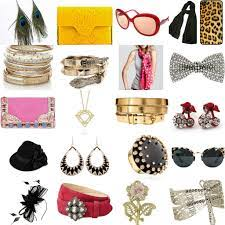Accessories works as Assets
What are accessories, and do you really need them to complete the look?
Accessories are the finishing touches of color, texture and shape that impact your image. The role they play is important. They reflect your style philosophy and pull your other selections together to create groupings that make design sense.
To fully appreciate the impact accessories make, let’s consider other examples of things that require a “finishing touch”. Can you picture: - a cake without icing?
Accessories give one an extra dose of beauty, a little more sparkle, just by looking at you because they’re a natural icebreaker.
So, here are some of the more timeless guidelines: -
Don’t crowd your face: It means , either wear big earrings or a major necklace but not both. Concentrate on one focal point per body part. Pair a necklace and ring, or a bracelet, earrings and necklace.
Harmonize Accessories with your Outfit: Make it sure there must be some common element or theme between the accessory and the outfit. This could be color, perceived weight, texture or some other style or design element.
Harmonize Accessories with Each Other : In addition it’s a good idea to harmonize accessories with each other in the same outfit. For example, similar silver buckles on shoes and handbag. However, take care to have some contrast in your look. Complete sameness can be boring and aging.
Consider your Body Scale: It’s always better to choose a size that's in harmony with your body scale. Small scale choose small to medium accessories. Medium scale any size accessory will work for you and for large scale medium sized accessory will work for you.
Accessories as Focal Points: Focal points are things that attract attention such as a bright color or a striking design. The aim is to use focal points to attract attention to your good points and minimize or detract from your figure challenges.
It's easy to ruin an otherwise great outfit by choosing the wrong accessories. Or in other words we can say that, it's easy to make an ordinary outfit look great with the right accessories. Accessories can work as great assets for you.

Comments
Post a Comment